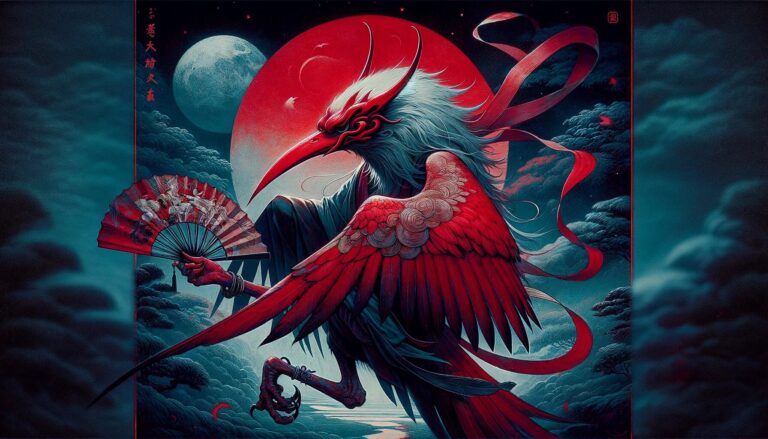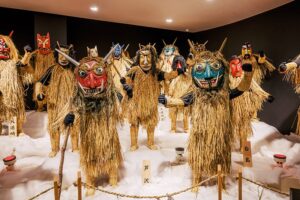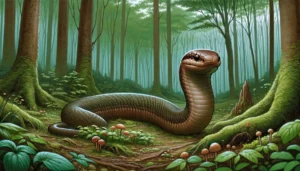Table of Contents
In the heart of Japanese mythology, amidst the dense forests and sacred mountains, dwell the enigmatic and captivating creatures known as Tengu. Furthermore, these beings, with their complex and multifaceted personalities, have been an integral part of Japanese folklore for centuries. Thus, to delve into the world of Tengu is to embark on a journey through a rich tapestry of legends, stories, and beliefs that have shaped the cultural landscape of Japan.
Origins and Evolution
The origin of Tengu veils itself in mystery, mirroring the enigmatic nature of these creatures. Some scholars attribute their roots to Chinese mythology, where they believe Tengu trace their lineage back to the Daoist deity Zhenwu. Zhenwu was depicted with a bird-like countenance and possessed martial prowess. Nevertheless, Tengu in Japanese culture have undergone transformation into a distinct entity, amalgamating elements from indigenous beliefs, Buddhism, and Taoism.
Interpretations of the term “Tengu” often lean towards “heavenly dog” or “heavenly sentry.” These beings typically manifest as humanoids with avian characteristics, most notably featuring a conspicuous, red, or elongated beak and the remarkable capability to take flight. In artistic depictions, Tengu are commonly shown clutching a fan known as Tengu-geta and a feathered fan called Tengu-ōgi. The color red finds a strong association with them, symbolizing not only their mystical powers but also their penchant for mischief.
The Many Faces of Tengu
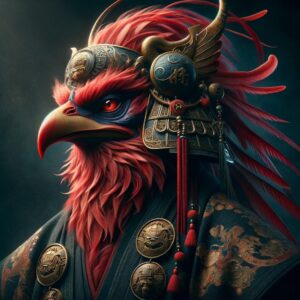
One of the most fascinating aspects of Tengu is their diverse nature. They are not a homogeneous group but rather a collection of distinct personalities and abilities. Throughout Japanese history, Tengu have been categorized into different types, each with its own unique characteristics. Here are some of the prominent Tengu varieties:
- Daitengu: These Tengu, classified as high-ranking, possess superior intelligence, martial expertise, and supernatural capabilities. They commonly assume leadership roles and serve as chiefs among the Tengu, recognized for their distinctive red attire and elongated masks.
- Karasutengu: Karasutengu, as the name suggests, are crow-like Tengu. They have a more bird-like appearance, with feathers and wings, and are associated with mischief and trickery.
- Konoha Tengu: These Tengu often feature human-like characteristics but embellish their appearance with tall, pointy hats crafted from leaves or vegetation. They possess proficiency in martial arts and frequently issue challenges to humans, engaging them in duels.
- Tengu-Kozo: Tengu-Kozo represent the young or apprentice Tengu, adopting the guise of young boys characterized by red faces and beaks. They gain notoriety for their penchant for playing pranks on humans.
- Kappa-Tengu: A fusion of Tengu and Kappa, these creatures have the webbed hands and amphibious nature of Kappa, combined with the Tengu’s bird-like features.
The Enigmatic Nature
Tengu are known for their capricious and unpredictable behavior. Additionally, they can be benevolent protectors or malevolent troublemakers, depending on their mood and the circumstances. Moreover, some legends portray them as guardians of the mountains and forests, protecting these sacred places from intruders and evil spirits. In this role, they are often seen as allies of the Shugendo practitioners, who seek spiritual enlightenment in remote, mountainous areas.
On the flip side, Tengu can be mischievous and even malicious. They are notorious for luring travelers off their paths, leading them astray in the mountains, and playing tricks on them. Tengu also possess the ability to exert control over humans, compelling them to display erratic and unpredictable behavior. People perceive this phenomenon as “Tengu Kojin,” viewing it as a divine retribution that punishes those who exhibit disrespect towards the natural world.
Appearance
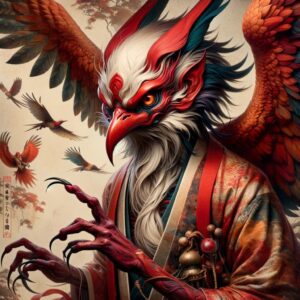
Artists typically depict Tengu as humanoid creatures boasting avian features. They possess bodies akin to humans but stand out with their prominent, elongated, or red-hued beaks. The coloration of their skin or feathers can vary, yet red remains a prevalent choice. Often, they sport sharp claws and may feature wings, granting them the ability to take flight. Furthermore, in addition to their distinctive beaks, their eyes are commonly rendered as intense and piercing in appearance. Tengu may wear traditional Japanese attire, including red robes or capes. Some varieties of Tengu, like the Karasutengu, have more bird-like appearances, with feathers covering their bodies and wings for flight. Their appearance can vary depending on the specific type of Tengu and the artistic representation in different stories and artworks.
In Buddhist and Shinto Traditions
Tengu deeply intertwine with both Buddhist and Shinto traditions in Japan. In Buddhism, practitioners view them as protectors of the dharma (Buddhist teachings) and associate them with the deity Fudo Myoo. Tengu, in this context, assume the role of fierce warriors who guard sacred sites and temples, ensuring protection from malevolent forces.
Within Shintoism, followers regard Tengu as spirits of the mountains and forests. They consider Tengu to be kami, divine spirits, inhabiting these natural landscapes. Tengu make appearances during specific festivals and rituals, their presence believed to bring both blessings and challenges to those encountering them.
In Folklore and Popular Culture
Tengu have left an indelible mark on Japanese folklore and continue to influence contemporary culture. Moreover, they are featured in numerous stories, plays, and artworks throughout Japan’s history. Notably, the Noh and Kabuki theater traditions often incorporate Tengu characters, bringing their unique personalities and abilities to life on stage.
Furthermore, in modern times, Tengu have made their way into popular culture through manga, anime, video games, and literature. Their portrayal varies from being wise and noble to being comical and mischievous, reflecting the adaptability of this mythical creature to different narrative contexts.
The Tengu’s Red Feathered Fan
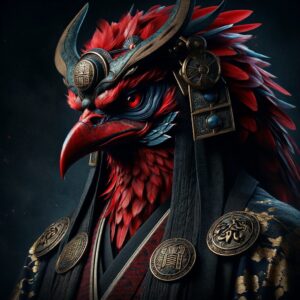
A distinctive and iconic symbol of Tengu is their feathered fan, known as the Tengu-ōgi. This fan has both symbolic and practical significance in Tengu mythology. Symbolically, it represents the Tengu’s supernatural powers and control over the winds. It is said that by waving the Tengu-ōgi, Tengu can summon strong winds and create storms.
In practical terms, the Tengu-ōgi is often used in their martial arts skills. Tengu are legendary fighters, and their fans are both weapons and symbols of their prowess. The fan can be used to deflect attacks, create illusions, and perform other supernatural feats, showcasing the Tengu’s agility and combat skills.
Legends and Tales
The stories and legends surrounding Tengu are as diverse as the Tengu themselves. Here are a few notable tales that highlight their various roles and attributes:
The Tale of Tengu and the Woodcutter
In the captivating Tale of Tengu and the Woodcutter, a humble woodcutter embarks on a journey deep into the heart of the mystical mountains, seeking firewood. Little did he know that his seemingly ordinary expedition would lead to an extraordinary encounter with a Tengu.
As the woodcutter ventured further into the dense forest, he stumbled upon a secluded glade, bathed in dappled sunlight. To his astonishment, a Tengu emerged from the shadows, its imposing figure both intimidating and awe-inspiring. However, instead of resorting to malevolence, this particular Tengu displayed an unexpected benevolence.
With a sense of purpose, the Tengu decided not to harm the woodcutter but rather to share a precious gift – the knowledge of martial arts. The Tengu, possessing unparalleled expertise in combat techniques, patiently instructed the woodcutter in the intricate forms and secret techniques of the warrior’s path. Their training sessions continued day after day, with the woodcutter absorbing each lesson with diligence and determination.
Under the Tengu’s guidance, the woodcutter’s skills flourished. His once calloused hands transformed into instruments of precision and strength. His movements became fluid, and his strikes, lethal. Gradually, he evolved from a simple woodcutter into a formidable warrior, armed not only with physical prowess but also with the wisdom bestowed by the Tengu.
With gratitude in his heart, the woodcutter bid farewell to the benevolent Tengu and returned to his village as a transformed man. Consequently, his newfound martial prowess earned him respect and admiration, and his story became a source of inspiration for generations to come. Therefore, this enchanting tale serves as a testament to the Tengu’s capacity for benevolence and their role as enigmatic mentors in the world of Japanese mythology.
The Battle of Uji Bridge
As the story unfolds high in the mist-covered peaks of Mount Kurama, a location steeped in mysticism, Sōjōbō emerges as the elder and chief of the Tengu. He had long been a guardian of this sacred realm, revered for his immense wisdom and formidable martial skills. In this epic tale, the fierce battle between Sōjōbō and Gama serves as a testament to their unparalleled martial prowess. Moreover, it illuminates their vital roles as guardians of the sacred mountains.
However, Gama, a younger and equally formidable Tengu, sought to challenge Sōjōbō’s supremacy. Their clash was nothing short of spectacular, with the mountains themselves trembling under the intensity of their battle. Each combatant demonstrated awe-inspiring agility and precision, their movements echoing the wind’s graceful dance through the treetops.
The battle between Sōjōbō and Gama raged on for days, a dazzling display of martial prowess that left spectators in both awe and trepidation. It showcased the Tengu’s unmatched combat abilities and emphasized their role as protectors of the mountainous domain, ready to defend it against any intruders or malevolent forces.
In the end, the battle concluded without a clear victor, as both Tengu warriors acknowledged each other’s strength and withdrew with mutual respect. Their conflict served as a testament to the Tengu’s unwavering dedication to their sacred duty as guardians and illuminated the timeless legends that continue to enshroud these enigmatic creatures in Japanese folklore.
Tengu and the Lost Traveler
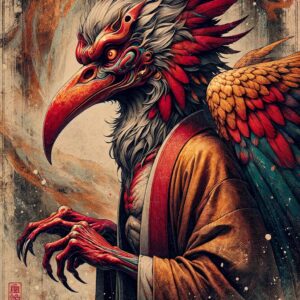
In the compelling narrative of “Tengu and the Lost Traveler,” a lone wanderer embarks on a journey through the rugged, mystical mountains of Japan, only to encounter an elusive and mischievous Tengu. This Tengu, with its knack for trickery, guides the traveler astray, setting in motion a series of trials and challenges that would forever change the traveler’s perspective.
The unsuspecting traveler ventured deeper into the remote wilderness, the Tengu appeared before him, cloaked in an aura of mysticism. With deceptive charm, the Tengu lured him off the beaten path, leading him into a labyrinthine maze of dense forests and steep cliffs. The traveler soon found himself lost, disoriented by the Tengu’s cunning ruse.
Throughout this ordeal, the Tengu continued to play tricks on the traveler, testing his patience and resilience. However, with each challenge, the traveler’s determination grew stronger. He learned to navigate the treacherous terrain, find sustenance in the wild, and appreciate the beauty of the natural world that surrounded him.
As the days turned into weeks, the traveler’s initial frustration gave way to a deep sense of respect for the mountains and the creatures that inhabited them, including the mischievous Tengu. In hindsight, he realized that the Tengu’s tricks had been a form of tough love, teaching him valuable life lessons about adaptability, humility, and the interconnectedness of all living beings.
In the end, the traveler emerged from the mountains, not as a defeated soul, but as a wiser and more enlightened individual. He carried with him the enduring lessons learned from his encounter with the Tengu, forever transformed by the trials and challenges that had tested his mettle and reshaped his understanding of the natural world.
Simiralities
Harpy (Greek Mythology). Harpies are bird-like creatures in Greek mythology with the body of a bird and the head of a woman. They share the avian aspect with Tengu, although their role and characteristics differ.
Garuda (Hindu and Buddhist Mythology). Garuda is a bird-like creature in Hindu and Buddhist traditions. It frequently appears with a humanoid body and possesses wings, a beak, and talons reminiscent of an eagle. Garuda earns recognition for its speed and strength, akin to Tengu’s supernatural capabilities.
Harpiai (Roman Mythology). The Harpiai, or Harpies in Roman mythology, resemble the Greek Harpies. They possess wings and feature the upper body of a woman combined with the lower body of a bird.
Phoenix (Various Mythologies). The Phoenix, present in various mythologies including Greek, Egyptian, and Chinese, represents a bird-like creature renowned for its ability to undergo rebirth and regeneration. Although its appearance varies from that of Tengu, both creatures share associations with birds and possess supernatural attributes.
Qilin (Chinese Mythology). The Qilin, also known as Kirin in Japanese, is a mythical creature with a mixture of traits, including aspects of a deer, dragon, and sometimes a bird. In some depictions, it has antlers or horns, which might be seen as a resemblance to Tengu’s long noses.
FAQ
What do Tengu look like?
Tengu typically have human-like bodies but are distinguished by their prominent, long, or red-nosed beaks. They may also have wings and sharp claws.
What is the significance of Tengu in Japanese culture?
Tengu have a complex role in Japanese culture, representing both protectors of the mountains and forests and mischievous tricksters.
Are Tengu benevolent or malevolent?
Tengu can exhibit both benevolent and malevolent traits, depending on the context and their mood. They are known for their capricious behavior.
What are some famous Tengu stories?
One famous tale involves a woodcutter who learns martial arts from a Tengu. Another tells of epic battles between powerful Tengu, like Sōjōbō and Gama.
Are there different types of Tengu?
Yes, there are various types of Tengu, including Karasu Tengu (crow-like), Tengu-Kozo (young Tengu), and high-ranking Tengu, each with its own characteristics.
What is "Tengu Kojin"?
"Tengu Kojin" is the phenomenon where Tengu can possess humans, causing them to exhibit erratic behavior. It's often seen as divine retribution for disrespecting the natural world.
How do Tengu relate to other mythical creatures?
Tengu share some similarities with creatures like Harpies, Garuda, and the Phoenix, as they are all associated with bird-like attributes and have supernatural abilities.
What role do Tengu play in Japanese mythology today?
Tengu continue to be a source of inspiration in Japanese culture, appearing in various forms of media such as manga, anime, and literature. They remain an enduring part of Japanese folklore.
